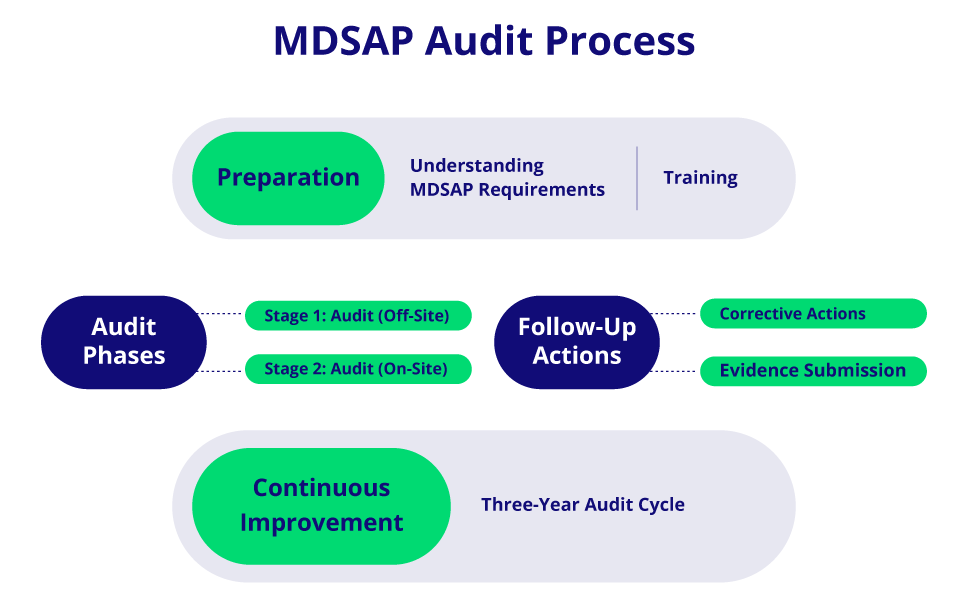What is MDSAP?
The Medical Device Single Audit Program (MDSAP) allows a single regulatory audit of a medical device manufacturer’s quality management system, meeting the requirements of multiple regulatory authorities. MDSAP aims to streamline the auditing process, reducing the burden on manufacturers by eliminating the need for multiple audits from different regulatory bodies. Covering the entire lifecycle of a medical device—from design and development through production and post-market surveillance—MDSAP ensures compliance with the regulatory requirements of participating countries.
Goals of MDSAP
The primary goals of MDSAP include:
- Enhancing patient safety and device effectiveness
- Reducing regulatory burden on manufacturers
- Facilitating global market access
- Promoting international regulatory cooperation
- Improving audit efficiency and consistency
- Supporting innovation in the medical device industry
Participating Regulatory Authorities
The following regulatory authorities participate in the MDSAP:
- United States (FDA): Collaborates in the development of MDSAP audit standards and procedures and recognizes MDSAP audit reports as part of its regulatory assessment processes.
- Canada (Health Canada): Uses MDSAP audit reports for licensing and monitoring medical devices within Canada.
- Australia (TGA): Accepts MDSAP audit reports as part of its regulatory assessments, promoting efficient and consistent evaluations of medical devices.
- Japan (MHLW & PMDA): Utilizes MDSAP audit reports to streamline regulatory processes, ensuring medical devices meet Japanese safety and efficacy standards.
- Brazil (ANVISA): Incorporates MDSAP audit reports into its regulatory framework, facilitating market entry for compliant medical devices.
Benefits of MDSAP Certification
- Enhanced market access
- Streamlined regulatory compliance
- Cost and time efficiency
- Improved product quality and safety
- Increased regulatory confidence
- Competitive advantage
- Support for innovation
- Proactive compliance
MDSAP Audit Process
Preparation
- Understanding MDSAP Requirements: Familiarize yourself with MDSAP requirements, objectives, and specific regulations of participating countries.
- Training: Consider undergoing MDSAP training or consulting with experts.
Audit Phases
- Stage 1 Audit (Off-Site): The auditing organization (AO) reviews your QMS documentation remotely and plans the on-site audit.
- Stage 2 Audit (On-Site): The AO conducts a thorough on-site audit of your QMS, beginning with an opening meeting, followed by the evaluation, and concluding with a closing meeting.
Follow-Up Actions
- Corrective Actions: Implement corrective actions to address any non-conformities identified during the audit.
- Evidence Submission: Submit evidence of corrective actions taken to the AO.
Continuous Improvement
- Three-Year Audit Cycle: Throughout the three-year audit cycle, manufacturers must continuously monitor and improve their QMS, using audit feedback to enhance quality and compliance. This proactive approach ensures preparedness for the next audit phase.

How to Apply for MDSAP
Understanding MDSAP Requirements
- Familiarize yourself with MDSAP requirements and objectives.
- Undergo MDSAP training or consult with experts.
Evaluate and Prepare Your Quality Management System (QMS)
- Conduct an internal gap analysis to identify discrepancies.
- Ensure all QMS documentation is up-to-date.
- Address any identified gaps or deficiencies.
Select an Auditing Organization (AO)
- Identify authorized AOs.
- Contact AOs for proposals.
- Choose based on expertise, availability, cost, and reputation.
Application Submission
- Complete the MDSAP application form.
- Submit necessary documentation.
- Pay the required application and audit fees.
Initial Certification Audit
- Schedule the initial audit with the AO.
- Stage 1 Audit (Off-Site): AO reviews QMS documentation.
- Stage 2 Audit (On-Site): AO conducts an on-site audit and provides a detailed audit report.
Address Non-Conformities
- Develop and implement corrective action plans.
- Submit evidence of corrective actions to the AO.
Certification Decision
- AO reviews corrective actions and compliance.
- If requirements are met, the AO issues the MDSAP certificate.
Surveillance Audits
- Schedule annual surveillance audits.
- Surveillance Audits (On-Site): AO conducts focused evaluations.
Re-Certification Audit
- Preparation: Prepare for the re-certification audit.
- Re-Certification Audit (On-Site): AO conducts a comprehensive audit.
- Certification Renewal: Upon successful completion, the MDSAP certification is renewed for another three years.
Related Programs and Certifications
ISO 13485 an international standard specifying requirements for a QMS where an organization needs to demonstrate its ability to provide medical devices and related services that consistently meet customer and regulatory requirements.
Resources
For additional help or clarification regarding MDSAP, contact the relevant regulatory authorities.
Choose Rook Quality Systems
RookQS assists with every step of the MDSAP process
- Gap Analysis: Conduct internal audits before the official audit.
- Audit Assistance: Support during the external audit.
- Quality Maintenance: Help maintain quality standards between audits.
